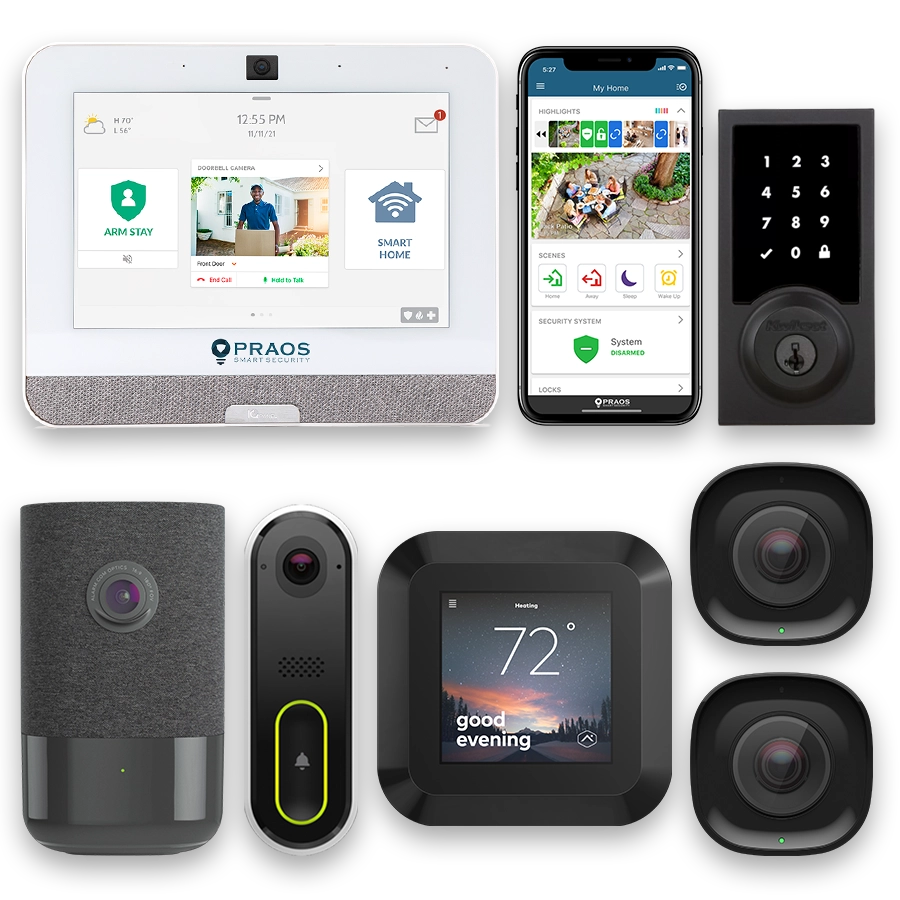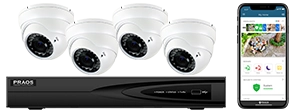- The Evolution of Home Security Systems
- Wireless Camera Technology: Advancements and Benefits
- Intrusion Detection Systems: Modern Approaches and Effectiveness
- Integration of Wireless Cameras and Intrusion Detection in Smart Homes
- Privacy and Security Concerns in Wireless Home Security Systems
- Future Trends in Wireless Cameras and Intrusion Detection for Home Security
The Evolution of Home Security Systems
The concept of home security has undergone significant transformations over the years. Traditional home security systems primarily relied on physical barriers and human surveillance to protect properties. Over time, technological advancements have played a crucial role in enhancing the effectiveness of these systems.
In the early 20th century, the advent of telecommunication-enabled alarm systems marked a substantial improvement. These systems used telephone lines to notify authorities when an alarm was triggered. Despite their effectiveness, they had limitations such as susceptibility to line tampering and the inability to provide real-time updates.
With the rise of digital technology in the late 20th and early 21st centuries, home security systems began to incorporate electronic and computerized components. This period saw the introduction of more advanced sensors, including motion detectors and glass break sensors, which significantly improved intrusion detection capabilities.
Another critical milestone in the evolution of home security is the development of video surveillance systems. Initially, these systems involved closed-circuit television (CCTV) setups that could record events within a property. Modern video surveillance incorporates internet connectivity, enabling real-time monitoring and remote access.
The introduction of wireless technology has revolutionized home security systems. Unlike wired systems, wireless solutions are easier to install and expand, as they do not require extensive infrastructure modifications. They offer flexibility in placing sensors and cameras, ensuring comprehensive coverage of the property.
The proliferation of smart home technology has further enhanced the capabilities of home security systems. Integration with smart home ecosystems allows for seamless control and monitoring through smartphones and other connected devices. This development has made it possible for homeowners to receive real-time alerts and control their security systems remotely.
Wireless cameras and intrusion detection systems represent the latest advancements in home security technology. These innovations leverage advancements in wireless communication, artificial intelligence, and cloud computing to offer robust and reliable security solutions. As a result, modern home security systems are more effective, user-friendly, and adaptable than ever before.
Wireless Camera Technology: Advancements and Benefits
Wireless camera technology has seen significant advancements over the past decade, playing a pivotal role in modernizing home security systems. Traditional wired cameras, while effective, posed several limitations including complex installations and restricted placement options. Conversely, wireless cameras provide more flexibility and improved functionality, making them a preferred choice for contemporary home security solutions.
One of the most substantial advancements in wireless camera technology is the enhancement of image quality. Early wireless cameras often suffered from poor resolution and lag issues. Today, many wireless cameras offer high-definition (HD) and even 4K resolution, ensuring detailed and clear footage. This clarity is crucial for identifying faces, license plates, and other critical details during security breaches.
Battery technology has also seen improvements, allowing for longer operational periods without frequent recharging. Lithium-ion batteries, commonly used in wireless cameras, offer a good balance of long life and quick recharge times. Additionally, solar-powered options are becoming increasingly popular, providing an environmentally friendly and maintenance-free power solution.
Another noteworthy development is the integration of advanced sensors and analytics. Modern wireless cameras now often include motion detection, facial recognition, and even thermal imaging. Motion detection reduces power consumption and storage needs by recording only when activity is detected. Facial recognition can differentiate between familiar and unfamiliar faces, enhancing the accuracy of alert systems. Thermal imaging aids in low-light or no-light conditions, ensuring 24/7 surveillance capability.
Wireless cameras now often support cloud storage, allowing footage to be stored remotely and accessed from anywhere. This eliminates the risk of losing data in the event the camera or the physical storage device is tampered with. Many manufacturers also offer subscription-based cloud storage services that include additional features such as extended storage durations and enhanced data encryption.
The user-friendliness of wireless cameras has significantly increased, thanks to smartphone integration and intuitive interfaces. Homeowners can easily monitor their properties in real-time through dedicated apps, which often include features like livestreaming, two-way audio, and instant alerts. Some systems can be integrated with other smart home devices, allowing comprehensive control through a single interface.
Network security remains a critical consideration in wireless camera technology. Encryption protocols such as WPA2 and WPA3 are commonly implemented to secure the communication between the camera, the local network, and cloud services. Manufacturers also regularly update firmware to address vulnerabilities and enhance security features, ensuring that systems stay protected against new threats.
In summary, wireless cameras have transformed home security by offering high-resolution imaging, advanced sensors, extended battery life, cloud storage options, user-friendly interfaces, and robust security measures. These advancements not only enhance the effectiveness of home security systems but also offer greater convenience and peace of mind for homeowners.
Intrusion Detection Systems: Modern Approaches and Effectiveness
Intrusion detection systems (IDS) play a crucial role in modern home security by providing a robust layer of protection against unauthorized access. These systems have evolved significantly over the years, and contemporary IDSs are more sophisticated, reliable, and effective than ever before.
Modern intrusion detection systems employ a combination of advanced sensors, algorithms, and networked devices to detect potential security breaches. This multi-faceted approach enhances the overall security posture of residential properties by offering timely alerts and comprehensive monitoring capabilities.
Types of Sensors
Contemporary IDSs utilize various types of sensors to detect intrusions. The most common sensors include:
- Motion Detectors: Use infrared technology to detect movement within a specified area.
- Glass Break Sensors: Recognize the sound frequency of breaking glass, helping to detect forced entry through windows.
- Door and Window Sensors: Magnetic sensors that trigger an alarm when a door or window is opened without authorization.
- Shock Sensors: Detect vibrations or impacts, which can indicate attempts at physical tampering.
Advancements in Detection Algorithms
Detection algorithms have become more refined, leveraging machine learning and AI to minimize false alarms and provide more accurate detection. These algorithms analyze sensor data patterns, differentiate between normal and suspicious activities, and adapt to the specific environmental conditions of the home.
Integration with Other Security Systems
Modern IDSs do not operate in isolation. They are integrated with other security components, such as wireless cameras, to form a cohesive defense mechanism. Integration allows these systems to share data, enabling more accurate threat detection and a quicker response to potential intrusions.
For instance, when an intrusion is detected by the IDS, the system can automatically activate cameras in the affected area to record the event and provide real-time visuals to the homeowner or security personnel.
Remote Monitoring and Alerts
Another significant advancement in IDS technology is the capability for remote monitoring and instant alerts. Homeowners can receive real-time notifications on their smartphones or other devices when an intrusion is detected. This feature ensures that users can take immediate action, even when they are not at home.
Moreover, many intrusion detection systems offer professional monitoring services. When an alarm is triggered, these services can assess the situation and, if necessary, dispatch emergency responders to the property.
Effectiveness and Reliability
Studies and industry data indicate that modern intrusion detection systems are highly effective in preventing break-ins and minimizing property loss. For example, the Electronic Security Association reports that homes with security systems are up to three times less likely to be burglarized than those without.
Furthermore, advancements in sensor technology and detection algorithms contribute to the reliability of these systems, reducing the likelihood of false alarms and ensuring that real threats are promptly identified and addressed.
In conclusion, the evolution of intrusion detection systems has significantly bolstered the security of residential properties. These advancements, coupled with integration and remote monitoring capabilities, make modern IDSs a critical component in the protection of homes against unauthorized access.
Integration of Wireless Cameras and Intrusion Detection in Smart Homes
In the age of smart technology, the integration of wireless cameras and intrusion detection systems has revolutionized the approach to home security. These systems are designed not only to work together seamlessly but also to provide a comprehensive protection strategy that aligns with the concept of a modern, connected home. Praos has been at the forefront of implementing these technologies to ensure that homes in Richmond are safe, smart, and secure.
At Praos, the integration process begins with a customized approach tailored to each homeowner’s unique needs and budget. With a focus on creating a cohesive smart home security system, Praos combines wireless cameras and advanced intrusion detection in a single, user-friendly application. This integration is pivotal in transforming traditional security into a smart home experience.
Unified Control System
The core of this integration lies in the unified control system provided by Praos. Through a single connected app, users can monitor their security cameras, receive intrusion alerts, and control other smart home devices. This approach simplifies the management of home security and enhances overall user convenience.
With the Praos app, homeowners can:
- View live feeds from their wireless cameras.
- Receive real-time notifications of any detected intrusions.
- Control automated home systems such as lights and locks.
- Access historical data and security logs.
Advanced Wireless Cameras
Praos utilizes cutting-edge wireless cameras that are equipped with high-definition video quality, night vision, and motion detection. These cameras are strategically placed to cover the most vulnerable areas of a property, ensuring comprehensive surveillance. The wireless nature of these cameras eliminates the need for extensive wiring, making installation easier and less invasive.
The benefits of Praos wireless cameras include:
- High-definition video: Provides clear and detailed footage for accurate monitoring.
- Night vision: Ensures visibility and security during nighttime.
- Motion detection: Triggers alerts for any unusual activity, enhancing the system’s response capability.
Effective Intrusion Detection Systems
Praos also incorporates advanced intrusion detection systems that are designed to detect unauthorized entry attempts promptly. These systems use a combination of sensors and monitoring technology to provide immediate alerts, ensuring that any potential threats are quickly identified and addressed.
The key features of Praos intrusion detection systems include:
- Door and window sensors: Detect and alert upon unauthorized opening or tampering.
- Motion detectors: Identify movement within the home when the system is armed.
- 24/7 professional monitoring: Ensures that security experts are always available to respond to alerts.
Comprehensive Safety and Peace of Mind
The integration of wireless cameras and intrusion detection systems by Praos provides homeowners with an unparalleled level of security and peace of mind. With rates starting at just $19.95 per month, this affordable yet robust solution ensures that families and properties are well-protected at all times.
Overall, the integration of these technologies within smart home systems stands as a testament to how modern advancements can elevate home security to meet the demands of today’s connected world. Praos remains dedicated to delivering top-tier security solutions that safeguard what matters most.
Privacy and Security Concerns in Wireless Home Security Systems
With the increasing adoption of wireless home security systems, privacy and security concerns have emerged as critical issues. These systems, which often include wireless cameras and advanced intrusion detection technologies, offer immense benefits but also introduce potential vulnerabilities.
Data Privacy: One of the primary concerns revolves around data privacy. Wireless camera systems often store and transmit video footage to cloud servers. The potential for unauthorized access to this data poses significant risks. According to the Norton Cyber Security Insights Report, over 17 million Americans were victims of cybercrime in 2017, underscoring the importance of secure data handling practices by home security providers.
Network Security: Wireless systems depend heavily on Wi-Fi networks, which can be compromised if not adequately protected. According to a report by CNET, over 75% of Wi-Fi networks in urban areas remain susceptible to various forms of attacks, such as man-in-the-middle attacks or brute force attempts on password protections.
Security Measures:
- End-to-End Encryption: Ensuring that video feeds and intrusion alerts are encrypted throughout their journey from the device to the cloud server can mitigate unauthorized access.
- Strong Authentication: Implementing two-factor authentication (2FA) provides an additional layer of security, making it harder for intruders to gain access to the system.
- Regular Updates: Firmware and software updates address vulnerabilities and enhance the security features of the wireless equipment.
| Concern | Mitigation Strategy |
|---|---|
| Unauthorized Access to Video Footage | End-to-End Encryption and Strong Authentication |
| Wi-Fi Network Vulnerabilities | Secure Wi-Fi Configuration and Regular Updates |
| Data Breaches | Compliance with Data Protection Regulations such as GDPR |
Regulatory Compliance: Compliance with regulations is another crucial aspect. The General Data Protection Regulation (GDPR) in Europe mandates stringent data protection and privacy measures. Companies providing wireless home security systems must ensure that their practices align with such regulations to protect user data adequately.
User Responsibility: While service providers play a significant role in securing wireless home security systems, users also have responsibilities. Choosing strong passwords, enabling 2FA, and regularly updating device firmware are essential practices for maintaining security.
In conclusion, while wireless home security systems provide enhanced convenience and safety, addressing privacy and security concerns is paramount. Both service providers and users must stay vigilant to safeguard against potential vulnerabilities.
Future Trends in Wireless Cameras and Intrusion Detection for Home Security
The rapid advancement in technology in the realm of home security has set the stage for significant developments in wireless cameras and intrusion detection systems. As innovation continues to unfold, several trends are likely to shape the future of these devices, enhancing their efficacy and integration within smart homes.
Artificial Intelligence and Machine Learning
Artificial Intelligence (AI) and Machine Learning (ML) are expected to play a crucial role in the future of home security systems. AI can enhance the capabilities of wireless cameras by enabling features such as real-time facial recognition, motion detection, and even behavioral analysis. ML algorithms can improve the accuracy of intrusion detection systems by continuously learning from historical data to identify patterns and predict potential security threats.
5G Connectivity
The deployment of 5G networks promises to revolutionize wireless camera systems by offering significantly faster data transfer speeds and lower latency. This advancement will enable high-definition video streaming and quicker response times for security alerts, thereby improving the overall reliability and functionality of home security systems.
Cloud-Based Storage and Analytics
The adoption of cloud-based storage solutions is expected to increase, providing users with scalable and secure options for video footage storage. Additionally, cloud-based analytics can offer enhanced processing power for video analysis, facilitating features such as real-time threat detection and remote monitoring capabilities.
Edge Computing
Edge computing is poised to complement cloud solutions by processing data closer to the source, i.e., at the wireless camera or local gateway level. This approach reduces latency and bandwidth usage, allowing for faster and more efficient data processing, which is crucial for real-time security applications.
Enhanced Sensor Integration
Future home security systems are likely to incorporate a broader range of sensors beyond standard cameras and motion detectors. These may include environmental sensors for detecting smoke, gas, or sound anomalies, as well as advanced biometric sensors for identifying authorized users through fingerprints or voice recognition.
Interoperability and Standardization
As the number of smart devices in homes continues to grow, the need for interoperability and standardized communication protocols becomes increasingly important. Efforts towards creating unified standards will facilitate seamless integration and operation of various security devices, improving system reliability and user experience.
Increased User Customization
The future of wireless home security systems will likely offer greater user customization options, allowing homeowners to tailor security solutions to their specific needs. This may include personalized alert settings, custom surveillance zones, and adaptive system responses based on user behavior and preferences.
- Artificial Intelligence and Machine Learning: Enhanced real-time facial recognition, motion detection, and behavioral analysis.
- 5G Connectivity: Faster data transfer, low latency, high-definition streaming.
- Cloud-Based Storage and Analytics: Scalable storage, real-time threat detection, and remote monitoring.
- Edge Computing: Faster local data processing, reduced latency, bandwidth efficiency.
- Enhanced Sensor Integration: Inclusion of environmental and advanced biometric sensors.
- Interoperability and Standardization: Unified communication protocols for seamless device integration.
- Increased User Customization: Personalized alerts, surveillance zones, adaptive responses.
In conclusion, the future of wireless cameras and intrusion detection systems in home security looks promising, with advancements driven by AI, 5G, cloud computing, and enhanced sensor technologies. These trends aim to provide more efficient, reliable, and user-friendly security solutions, offering peace of mind to homeowners worldwide.





